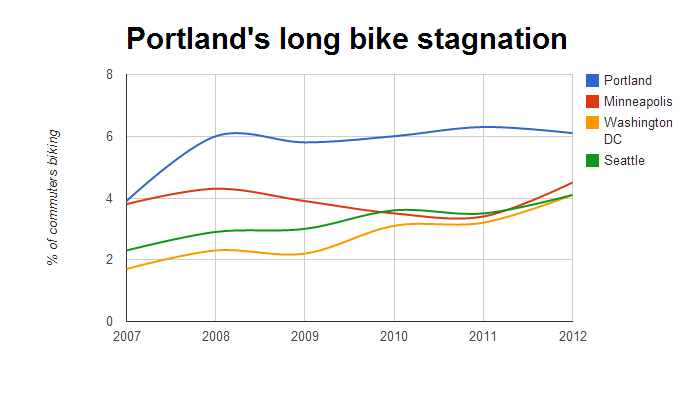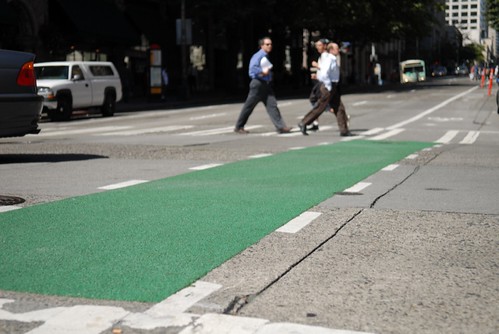
Portland’s hard-won status as “America’s bike capital” hasn’t looked less secure since it claimed the title in 2005.
The number of Portlanders who get to work primarily by bike was statistically unchanged in 2012, ticking from 6.3 percent to 6.1 percent of the city’s working population. Across the whole Portland metro area, bike use held at 2.3 percent.
Of the 25,000 net new workers in the metro area last year, the number of bike commuters only grew by 376, according to Census estimates. Inside city limits, the estimated number of bike commuters actually fell by 65, to 18,912.
Those figures are far within the Census survey’s margin of error. But the rises in biking last year in Minneapolis and Seattle, the country’s No. 2 and No. 3 large bike cities, weren’t.
Minneapolis’ bike mode share jumped from 3.4 to 4.5 percent, the sort of increase Portland hasn’t seen since the 2007 gas spike. Seattle’s rose from 3.5 to 4.1 percent. In each of those cities, the bike-commuting population grew by about 3,000 workers. If that absolute growth continued this year, Seattle — a somewhat larger city — may already have more total bike commuters than Portland does.
Some details: The Census’ American Community Survey measures self-reported commuting modes in April of each year. People are asked only to select only the mode with which they traveled the furthest distance in the previous week. And none of these figures reflects how people get around for non-work trips.
That said, Census figures are the best available measure of how well our city is performing compared to others, and there’s no question that work trips and non-work trips tend to move in concert.
Public transit use in Portland dropped relatively sharply last year, from 13 percent to 11.1 percent of workers in the city limits. These figures didn’t yet reflect the impact of TriMet’s big fall 2012 fare hike on most Portland-to-Portland trips, including the end of its downtown Free Rail Zone. It’s the lowest Census-estimated public transit mode share since at least 2000.
At the metro-area level, the transit drop was more modest, from 6.3 percent to 6 percent.
To the extent that Portland’s travel shifts last year were meaningfully large — and in most cases they weren’t — people seem to be slightly more likely to drive alone (the ratio ticked up from 57.9 to 58.5 percent) and significantly more likely to walk to work (from 4.9 percent to 6.9 percent, the highest walking mode share on record and the first time since 2007 that walking to work has been more popular among Portlanders than biking).
Walking seems to be up in similar cities, too: from 9 percent to 9.9 percent in Seattle and from 5.8 to 7 percent in Minneapolis.
Nationally, commuting patterns were essentially unchanged last year for biking (0.6 percent), walking (4.4 2.8 percent), riding transit (5 percent) and driving alone (76.3 percent).
You can explore Portland’s trends more here. There’s a wealth of more detailed Census data than this, so stay tuned for more insights over the next few months.

